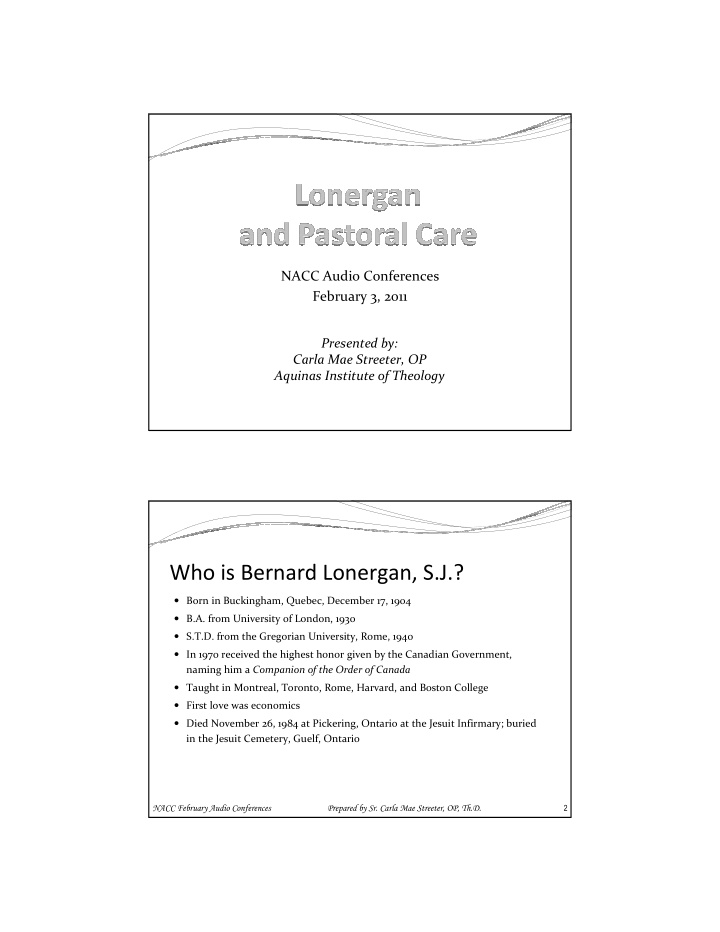



NACC Audio Conferences February 3, 2011 Presented by: Carla Mae Streeter, OP Aquinas Institute of Theology Who is Bernard Lonergan, S.J.? � Born in Buckingham, Quebec, December 17, 1904 � B.A. from University of London, 1930 � S.T.D. from the Gregorian University, Rome, 1940 � In 1970 received the highest honor given by the Canadian Government, naming him a Companion of the Order of Canada � Taught in Montreal, Toronto, Rome, Harvard, and Boston College � First love was economics � Died November 26, 1984 at Pickering, Ontario at the Jesuit Infirmary; buried in the Jesuit Cemetery, Guelf, Ontario ������������������������������� ��������������������������������������������� �
What is he up to? � A Jesuit, trained to be attentive to interior movements � Was fascinated by the working of Aquinas’ mind � “The intelligence can only be known in its act.” Summa Q. 85 � Read Newman’s Grammar of Assent six times � Became convinced philosophy was neglecting the subject’s own operations in the search for objective truth � Called for a “shift to interiority,” the charting of the operations of consciousness to identify intentionality as it moves from meaning to value in human decision � A second “axial shift” ������������������������������� ��������������������������������������������� � Charting the Operations of Consciousness � Experiencing: your senses, your own consciousness processing things; notice things; pay attention; listen; watch � Understanding: question to connect data, to make sense of things � Judging : a “yes” or “no” to data as fact, truth, reality � Deciding: evaluating the worth, weighing the value of what you know in order to act on it or not ������������������������������� ��������������������������������������������� �
Clarifying how we come to “know” anything � The recurrent, invariant, cross-cultural pattern � Knowledge comes with the judgment � The judgment is only virtually unconditioned � The judgment is objective � Objectivity is reached by authentic subjectivity � The human process involved in inspiration and infallibility ������������������������������� ��������������������������������������������� � Distinguishing “knowing” from “choosing” � Knowing seeks meaning � Meaning can be verbal, non-verbal, signed, mimed � Choosing flows from value informed by meaning � Value is concerned with worth � Worth gets one to choose, to decide, to act � A shift from intellect and will to cognitive and volitional operations ������������������������������� ��������������������������������������������� �
Why is this significant? � Because it calls us to accountability � We can be called to account not only for results, but how we got to them � This is called interiority analysis � It is morally and spiritually significant � It calls us to check what we intend � Intentionality becomes morally significant � Conscience formation becomes intentional � Can lead to transparent self-knowledge ecclesially, socially, politically, economically, and scientifically ������������������������������� ��������������������������������������������� � It explains how consciousness works � From the data of sense to the data of consciousness in my experience � Through questioning for intelligent understanding � Arriving at a judgment of fact based on understanding � To a decision based on an evaluative judgment of worth ������������������������������� ��������������������������������������������� �
Explains how consciousness is informed/formed/transformed � Informed: The questioning is key; if selective, or blocked, the judgment will be rash � Formed : Objectivity is reached in the judgment; if the inquiry is superficial, the judgment will be rash, the result of bias � Transformed: If the cognitive anthropology is accurate, sketching how we come to know , then it provides an explanation of developmental knowledge in any and all disciplines, and across cultures ������������������������������� ��������������������������������������������� � Provides language for dialogue � Doctors and medical personnel � Psychologists and psychiatrists � Counselors and therapists � Pastoral Care personnel � Spiritual Directors ������������������������������� ��������������������������������������������� ��
How do we begin? � Clarifying key terms: - consciousness - “levels” - intentionality - imperatives - vectors - bias ������������������������������� ��������������������������������������������� �� Explaining the levels of consciousness as self-reflexive � Experiencing myself as experiencing � Experiencing myself as understanding � Experiencing myself as judging � Experiencing myself as deciding � Experiencing myself as being grasped by religious love (God) in “religious” experience ������������������������������� ��������������������������������������������� ��
Identifying the contemplative core of consciousness � Consciousness as the self-aware psychic life force of the soul � The life force rooted in Divine Mystery � True even if not known or understood � The root of my being as creature � The root of original sin is forgetfulness � Returning to this core is going home � Recovery of this center is the source of authentic healing as distinguished from cure ������������������������������� ��������������������������������������������� �� Questions and Answers/Comments ������������������������������� ��������������������������������������������� ��
Recommend
More recommend